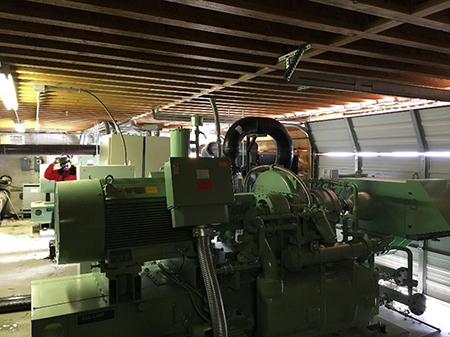
While most skiers naturally prefer to ski on real powder, nowadays, snowmaking is important to ski resorts around the world to meet the increased demand for winter tourism. Without snowmaking systems, most resorts would not be able to meet these demands—particularly at the beginning of the winter season.
Ski resorts typically supplement the natural snow using the snowmaking process, which also allows them to extend the length of their ski seasons; and air compressors are a vital part of this process.
The snowmaking process entails forcing water and pressurized air through a snow gun, which then blows into the air at below freezing temperatures to create snow. In other words, a snowmaking machine breaks the water into small particles; cools the water to 32°F; removes the heat of fusion; and nucleates.
The term for snow produced through this process is “technical snow.” Technical snow is like natural snow, as it consists of nothing more than air and water. However, the amount of water needed for this process can be surprising. For instance, to cover an area of 200 feet x 200 feet (61 meters x 61 meters) with six inches of snow, 20,000 cubic feet of snow is necessary. This would require 74,600 gallons (282,392 liters) of water!
Snowmaking systems typically operate at 100 percent capacity or are turned off. When the temperature drops below freezing, the entire system is turned on to maximize the amount of snow. Many ski resorts can convert more than 5,000 gallons of water per minute into snow. This is 20 tons per minute, or 1,250 tons per hour.

There are two types of snowmaking systems:
Roughly 75 percent of the cost of snowmaking is compressing the air, meaning users need the most efficient system possible. Users should also opt for oil free air compressors to avoid environmental contamination and potentially hindering the snowmaking production process.
For instance, many ski resorts are located on national forest land where environmental protection is paramount. This presents risks to resort operators if oil gets downstream, as this will be mixed with the water and blown onto the mountain.
Large air compressors – typically 300 hp or more – are ideal for Central Compressed Air Systems. That factor combined with protecting the environment, as well as the resort and its reputation, make centrifugal compressors an ideal fit. Centrifugal compressors can manage large air demands and operate at full capacity while running.
Air compressors are a critical component of the snowmaking process. Snowmaking not only helps extend a ski season but often sets a good base for the entire season. Thus, it’s important to find the right compressed air solution for your ski resort.
Use the checkboxes to select the types of cookies you want to accept, then press the “Save Settings” button. View our Privacy Policy.